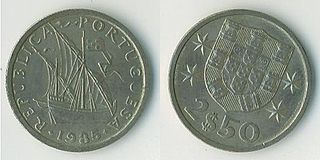Cifrão

The cifrão (Portuguese pronunciation: [siˈfɾɐ̃w̃] ) is a currency sign similar to the dollar sign ($) but always written with two vertical lines: ![]() . It is the symbol of the Portuguese currency (both historic and modern) and other past Brazilian currencies such as the Brazilian real (sign: R$; ISO: BRL) and is the official sign of the Cape Verdean escudo (ISO 4217: CVE).
. It is the symbol of the Portuguese currency (both historic and modern) and other past Brazilian currencies such as the Brazilian real (sign: R$; ISO: BRL) and is the official sign of the Cape Verdean escudo (ISO 4217: CVE).
It was formerly used by the Portuguese escudo (ISO: PTE) before its replacement by the euro and by the Portuguese Timor escudo (ISO: TPE) before its replacement by the Indonesian rupiah and the US dollar.[1] In Portuguese and Cape Verdean usage, the cifrão is placed as a decimal point between the escudo and centavo values (e.g., 2$50).[2] The name originates in the Arabic cifr.[3]
Character support
Support for the symbol varies. As of 2010[update], the Unicode standard considers the distinction between one- and two-bar dollar signs a stylistic distinction between fonts, and has no separate value for the cifrão. Mac OS X supplies the following fonts containing distinct cifrão signs:[citation needed] regular-weight Baskerville, Big Caslon, Bodoni MT, Brush Script MT, Garamond, STFangsong, STKaiti, and STSong ($). It can also be input by typing lowercase j in Bookshelf Symbol 7. In LaTeX, with the textcomp package installed, the cifrão () can be input using the command \textdollaroldstyle.
Because of the current difficulty supporting the character, $ is frequently employed in its place even for official purposes.[2][4]
Other uses
In Mexico, Colombia, and Chile, it was used for dollars, to distinguish from local currency which used the peso sign. However, the present convention in these countries is to use the peso symbol for dollars and specify USD (United States dollars) after the currency.
See also
- Letter and digit code for resistance and capacitance values (a similar scheme)
References
- ^ Lisbon-tourist-guide.com. "Portuguese Escudo." 2008.
- ^ a b Banco de Cabo Verde. "Moedas Archived 2011-01-22 at the Wayback Machine." Accessed 25 Feb 2011.
- ^ Casa da Moeda. "Origem do Cifrão". Casadamoeda.gov.br. Retrieved 11 March 2018.
- ^ Banco Central do Brasil. "Currency table." Accessed 24 Feb 2011.

